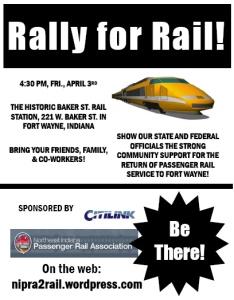
This Friday, at 4:30 pm at the Baker Street Train Station, Northeast Indiana Passenger Rail Association will be holding a Rally for Rail. Â The Rally will feature a speaker from Amtrak as well as local and state officials. Â A note – this group, NIPRA, is not advocating for high speed rail, rather passenger rail service which would run at Amtrak speeds, which is around 80 mph. Â The corridor could run as far east as Lima and terminate in Chicago. Â If you are interested in seeing passenger rail service back in town, attend the rally and show your support. Â Each day this week, I will feature an article or website that looks at passenger rail service in the United States. Â After the jump is today’s article.
Dennis Brown, Rural Business and Development Policy Branch of the Food and Rural Economics Division, wrote an article in 1999 entitled, When Rural Communities Lose Passenger Rail Service. Â Some excerpts from the article:
Some rural areas have recently had cutbacks in passenger rail service. While the loss of this service usually does not, by itself, threaten a town’s economic survival, it may have adverse effects that can be offset by public policy. This article explores some of the options available to these communities.
[…] Local opposition to proposed cutbacks in passenger train service can sometimes be very effective in ensuring that Amtrak service is preserved. When combined with the involvement of State and Federal officials, well-organized opposition can be an important element in preventing the loss of train service, as the following examples illustrate.
[…] The experiences of Quincy and Meridian indicate that local opposition to service cutbacks can sometimes make a difference. Whereas Quincy succeeded largely due to a recognition of the importance of Amtrak by the State, Meridian’s success resulted more from a combination of effective local leadership and involvement of key Federal officials.
[…] Not all communities have the flexibility of pursuing alternative modes of transportation when passenger rail service is lost. But the experience of Marion, Indiana, illustrates that communities in such situations can still benefit when they lose Amtrak service.
[…] In 1986, Marion permanently lost passenger rail and freight service on Amtrak’s Cardinal route connecting Washington, DC, with Chicago, when the host carrier, Chesapeake & Ohio (since renamed CSX Corporation), changed the route. Some residents of Grant County were deprived of an important link to Chicago, the most popular destination, and, to a lesser extent, to Cincinnati. Although local travelers can still get to these destinations via intercity bus service, all routes connect through
Indianapolis, which makes the trip much longer. For example, the 3 1/4-hour train ride to Chicago now takes 8 hours by bus, and the 4-hour train trip to Cincinnati is 8 hours by bus.[…] While the loss of passenger rail service by a small community will not usually, by itself, threaten its economic survival, it may have adverse effects that can be offset by public policy. For this reason, it is important that communities carefully consider their options when faced with service cutbacks and look to the examples of other towns that have come out ahead.